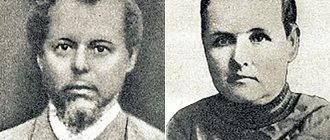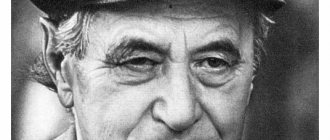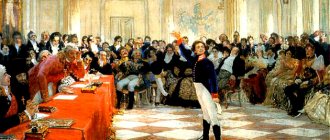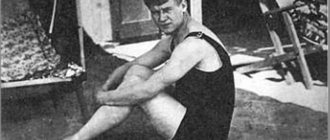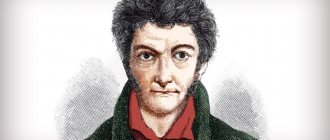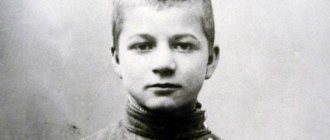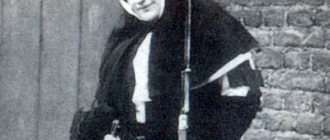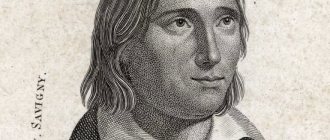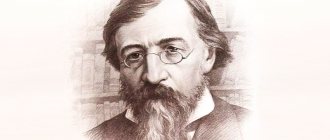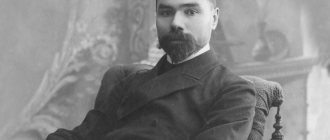Report on Chekhov
Anton Pavlovich Chekhov was born on January 29, 1860 in the city of Taganrog.
Chekhov wrote almost nothing specifically for children. Only the story “White-fronted” is directly addressed to children; even the textbook “Kashtanka” was revised for young readers. He ironically defined children's literature as “so-called”; he did not consider it real literature; he ridiculed it for its poor language, second-rate nature, and unnaturalness. Best of all, he formulated what is still a discovery for many: “Children should be given only what is suitable for adults.”
Chekhov’s common phrase: “I had no childhood as a child” is certainly true. He had suffered enough from his stern father, an unsuccessful grocery store owner who often used rods. The children helped with the housework, sang in the church choir, causing affection to the adults, and at the same time feeling like “little convicts.”
The Taganrog boy had his own joys: the sea, the handsome Don, the steppe, reading, home performances, going to a real theater. There were also sorrows: boring studies at the gymnasium, the need to earn money to send it to Moscow, where the bankrupt father fled from debtor's prison along with the rest of the family. From the protracted gymnasium “imprisonment” (Chekhov stayed for the second year twice), came the funny nickname “Chekhonte”, which was awarded to him by the teacher of the Law of God, who “pleased” his mother with the message that nothing good would come of her children. How often such judgments are wrong!
In 1879, Chekhov entered the medical faculty of Moscow University. Again I had to study and work to support my family. The main income came from literature. The first publication of Anton Chekhov's stories “Letter to a learned neighbor” and “What is most often found in novels, stories, etc.?” (magazine “Dragonfly”, 1880).
His short stories flooded humor magazines and newspapers. He wrote so much that, in addition to the most famous pseudonyms: “Antosha Chekhonte”, “My Brother’s Brother”, “The Man Without a Spleen”, he came up with several dozen more. The author’s natural observation, the ability to turn almost any subject into the theme of a funny story, the liveliness of the language and the special “theatricality” of the stories, where the heroes, like actors on stage, played out their roles, made a huge impression on readers. Among his stories there are many true masterpieces. What, it would seem, can be learned from an ordinary case when a hero remembers the name of a person? And we revel in the author’s ingenuity, his ability to “stretch” the plot, cheerfully playing with details (“Horse Name”). And what a hilarious circus performance the writer turns fishing (“Bubot”) into! Chekhov did not have to look for themes and plots; life itself offered them. A practicing doctor, he saw different people, visited different places, crossed the whole country to work in the most terrible Russian prison on the island of Sakhalin. Gradually, humor disappears from his work. He writes about people who are hopelessly unhappy. Among the many heroes who evoke the author’s strongest, heart-pounding sympathy are children.
Vanka Zhukov, a nine-year-old boy apprenticed to a shoemaker (“Vanka”), in his heartbreaking letter to his grandfather, describing endless humiliation, begging “take me away from here, otherwise I’ll die,” crosses out the illusory hope of salvation by writing the address on the envelope “On grandfather's village Konstantin Makarych." The child does not know the address to which he should turn for help, there is no such address... In the story “Boys” one of the main Chekhov themes is the theme of failure, bad luck. Two high school students who gathered in America for gold seem funny. Their enterprise turned into a complete embarrassment: in the Gostiny Dvor of the nearest city, they asked where to buy gunpowder, and were caught. But Volodya’s feelings: pity for his mother, shame, repentance, fear of punishment are not funny at all. Warmth and light fill Chekhov's stories about children (“Grisha”, “In the Nursery”). The stories about a sick puppy warmed by a she-wolf (“White-fronted”) and about a dog lost in a winter blizzard (“Kashtanka”) are warmed with kindness and tenderness.
The boy Yegorushka (the story “The Steppe”) experiences a happiness rare for Chekhov’s heroes, discovering the vast, free beauty of nature... Acquaintance with these works of Chekhov allows us to better understand his adult prose and drama.
Other interesting works on this subject:
Report on Maxim Gorky
Works of A.P. Chekhov
tags:
Creativity, Mikhail, Story, Creative, Life, Writer, Man, Gymnasium “The Life and Work of A.P. Chekhov.”
PLAN
1. A.P. Chekhov is an outstanding Russian prose writer and playwright.
2. Chekhov’s childhood and youth:
- a) education at the Starokostyantynivsky school;
- b) the first literary experiments of the future writer while studying at the gymnasium.
3. Chekhov’s entry into the medical faculty of Moscow University.
4. The first publications of Chekhov’s humorous stories in the magazines “Dragonfly” and “Oskolki”.
5. Publication of the writer’s first collection of stories, “Tales of Melpomene.”
6. Exposure of Chekhov’s contemporary reality in the stories “Surgery”, “Chameleon”, “Death of an Official”.
7. “Motley Stories” - sums up what has been done.
8. The role of medical practice in expanding the writer’s experience.
9. Writing the books “From Siberia”, “Sakhalin Island” under the impression of a trip to Sakhalin Island.
10. Chekhov’s educational activities during his stay at the Melikhovo estate.
11. A new stage in Chekhov’s work - drama studies:
- a) innovation of Chekhov the playwright;
- b) features of the play “The Seagull”;
- c) other dramatic works - “The Cherry Orchard”, “Three Sisters”.
12. Chekhov’s friend with Olga Knipper.
13. Raptova’s death of the writer during treatment at the German resort of Badenweiler.
A. Chekhov is an outstanding Russian prose writer and playwright. He raised the short story genre to an unattainable height and said a new word in dramaturgy.
Anton Pavlovich Chekhov was born on January 17, 1860. in Taganrog in the family of a small shopkeeper. His father, Pavel Yegorovich, was fond of church singing, led the church choir, and played the violin. His abilities were passed on to his five children: Alexander and Anton became writers, Nikolai became an artist, Maria became a teacher, and Mikhail became a world-class actor.
Although his wife was against it, Pavel Chekhov sent his sons to the Tsarekostyantin school, from where the children soon had to be removed, since they did not gain any knowledge.
In 1876, Chekhov's father went bankrupt and moved with his family to Moscow. Anton stayed in Taganrog on his own because he had to finish high school. However, Anton did not show any special abilities in the gymnasium, where he completed the eight-year course in ten years, staying in the third and fifth grades for two years. But the reason for this was not mediocrity. Yo-
4 pp., 1648 words
Theme “My favorite writer” (Anton Pavlovich Chekhov)
…perfect their own literary style. Translation My favorite writer is Anton Pavlovich Chekhov. In my opinion, he is the greatest Russian playwright ... newspapers in Russia, and Chekhov was invited to collaborate regularly. Chekhov, as a recognized writer, managed to develop his own... went to Sakhalin. His stay on Sakhalin became one of the brightest periods in his life for Anton Chekhov. After Chekhov went...
I just didn’t have time to study. The guy was very busy in Fatherland
cue bench and church choir. And yet, if there had not been a church choir and singing in Chekhov’s life, there would not have been his wonderful stories “Art”, “Bishop”, “Student”, “Holy Night” with the amazing beauty of simple believing souls, with a brilliant knowledge of church services, ancient Russian language. And the tiring sitting in the shop did not pass without a trace for Chekhov: it gave him, according to I. A. Bunin, “an early knowledge of people, made him more mature, since his father’s shop was a club of Taganrog residents, local peasants, and Athonite monks.”
The difficult impressions of childhood and youth will later be reflected in Chekhov’s stories about children. Just remember his stories like “Vanka” and “I Want to Sleep.” He also has a unique series of stories about teachers - “The Man in a Case”, “Gooseberry”, “About First Love”. During his years of studying at the gymnasium, the future writer read a lot, wrote essays for the humorous gymnasium magazine “Zaika”, where he showed himself as a professional critic, vividly and figuratively talking about what he read and saw.
However, Anton Pavlovich decided to devote his future to medicine. In 1879, after graduating from high school, he received a small scholarship and moved to his family in Moscow, where he entered the medical faculty of Moscow University. However, there was not enough money to live on, and Chekhov began to actively collaborate in magazines: he wrote short stories and sent them to various publications. In 1880, the first publications of his humorous stories appeared in the Dragonfly magazine, which quickly gained fame. He publishes his humoresques under a variety of funny pseudonyms: Baldastov, My Brother's Brother, The Man Without a Spleen, Antonson, Antosha Chekhonte...
Chekhov's literary earnings often turn out to be the only income in the family, where he soon becomes the chairman of the great clan. That is why not all works written by Chekhov are equally artistic. He writes works of different genres: he starts with parodies, from which he moves on to humorous essays and sketches.
Chekhov is also published in various publications, where his stories are accepted, but still he prefers the magazine “Oskolki”, where a special section was created for him called “Fragments of Moscow Life”. Some of his stories of those years received very flattering reviews, and among them are “Anyuta”, “The Pharmacist”, “The Husband”. In the first five years, Chekhov wrote about 400 such stories, recreating in them people of different professions and social strata: actors, doctors, military men, merchants, teachers, writers, priests, officials and many others. All aspects of life became the object of Chekhov's artistic interests. The writer ridiculed ordinary people, so comedy and irony constituted the main feature of his work.
In 1884, the first collection of stories by Anton Pavlovich Chekhov was published, positively assessed by critics - “Tales of Melpomene”, which included six stories from the life of theater people.
15 pages, 7420 words
Analysis of the story “Ionych” by Chekhov: theme, idea, essence, meaning of the work
... the story by A.P. Chekhov “Ionych” essay The boredom and dullness of life described in the story by A.P. Chekhov “Ionych” essay The image of the main character of the story by A.P. Chekhov “Ionych” essay The environment of the main character of the story by A.P. Chekhov “ Ionych” essay Analysis of Chekhov’s story “Ionych” The main theme of A. P. Chekhov’s work “Ionych” ...
1884 turned out to be a very successful year for Chekhov. Upon graduating from university, he was already the author of such wonderful works as “Surgery”, “Chameleon”, “Book of Complaints”, “Death of an Official”, “Thick and Thin”, which would later be considered programmatic in his work. All of them grew out of small stories, anecdotes, funny skits and essentially turned into a satirical denunciation of Chekhov’s contemporary reality. His stories - short stories - are epic works that pose great moral and psychological problems. Chekhov in his works is a master of artistic detail.
The year 1886 was a turning point in Chekhov's work. Having published the book “Motley Stories”, he seemed to sum up what he had done in order to move to a new, higher level of creative development.
In his literary activities, Anton Pavlovich did not forget that he was a doctor. Doctors become the main characters of his works, and he describes the psychology of his characters with purely medical care. Even readers unfamiliar with Chekhov’s biography will understand that the writer who created such works as “Ward No. 6”, “A Case Study”, “A Boring Story”, “The Seizure” is a doctor by profession. The writer's other stories - "The Black Monk", "The Man in the Case", "Ionych", "The Lady with the Dog" - also became masterpieces in which we see a deep analysis of reality, given in complete artistic images. The writer refuses moral preaching, but deeply explores life phenomena.
Medical practice, without a doubt, expanded the writer’s life experience: after all, people came to him not only with various diseases, but also with different destinies. Therefore, it is not surprising that in Chekhov’s works there are different characters and social strata. However, critics often accused Chekhov of depicting in his stories a gloomy and gray world in which there is no place for a “living person,” as if this world is seen through the eyes of a sick person. However, the writer by nature was a cheerful and cheerful person. He was attached to his family, loved his sister and brothers.
Anton Pavlovich becomes more and more demanding of himself over the years and experience. Now he no longer strives to immediately publish his works, and works for a long time on each new story. Gradually, the writer got ideas for more voluminous works, and he began to write stories - “The Steppe”, “Men”, “In the Ravine”, “My Life”.
At the end of the 80s, Chekhov experienced dissatisfaction with his “small affairs”, medical practice in the provinces, and the construction of schools and libraries. And after the death of his brother, he feels inner devastation. It begins to seem to him that he has stopped in his development and does not see any further prospects. Under the influence of these pessimistic sentiments, Chekhov, already seriously ill with tuberculosis, goes on a difficult trip to Sakhalin - the place of the tsar's penal servitude, in order to gain new impressions while traveling.
6 pages, 2569 words
Review of Chekhov's stories and stories (Chekhov A.P.)
... a common noun, the writer gave the story when including it in the Collected Works. Grief (p. 113).—According to M.P. Chekhov, the theme of the story was drawn by the writer from the life of Chikinskaya ... October,” 1944, No. 7-8). The horse's surname is Jaeger (p. 103).—The story “Jager” was destined to play an important role in the life of the writer. Chekhov grew rapidly. Stories “Death of an Official”, “Daughter of Albion”, “Chameleon” ...
In April 1890, the writer went through Kazan, Perm, Tyumen and Tomsk to the shores of the Pacific Ocean, overcoming four and a half thousand layers on horseback, and only at the end of July he arrived on Sakhalin. What he saw on the road to Sakhalin and on the island itself deeply shocked the writer. The existence of the people there could hardly even be called life. Never before had the writer encountered such hopeless poverty, savagery and complete arbitrariness of representatives of local authorities. Chekhov conveyed all these impressions in the books “From Siberia” and “Sakhalin Island”.
Immediately after his trip to Sakhalin, Chekhov made a large trip abroad. He visits Europe, and then Hong Kong and Singapore. Perhaps the contrast of impressions helped the writer to feel even more deeply the problems of Sakhalin Island and Russia as a whole.
Soon after this trip, in 1892, Chekhov stopped practicing medicine and bought the Melikhove estate near Moscow. A village teacher, he built a school at his own expense and helped the starving. During the cholera epidemic, the writer worked as a local sanitary doctor.
However, he refused any remuneration for his work, so as not to bind himself to any responsibilities.
And now. P. Chekhov is already a nationally recognized writer; One after another, collections of his stories are published - “Innocent Stories”, “In the Dark”.
in 1888 he became a laureate of the Pushkin Prize, and in 1900 - an honorary academician. The writer received this title at the same time as L.M. Tolstoy. However, Chekhov soon leaves the academy along with. G. Korolenko as a sign of protest when, by order of Nicholas II, they refused to accept G. Gorky.
A new stage in Chekhov's work is associated with his studies in dramaturgy. Chekhov was not only a skilled artist of prose, but also a great innovative playwright. The innovation of Chekhov the playwright lies primarily in his creation of a new type of dramatic conflict, where external conflicts were replaced by deep conflict in plots and situations. Chekhov's dramaturgy is also distinguished by the slow pace of development of events, the reproduction of a flow of events that are outwardly unrelated to each other (instead of the traditional “single action.” At first, he reworked some of his stories into plays, but they were not very successful, as happened with his play “Ivanov "
An important event in Chekhov’s life was his rapprochement with the Mrskovsky Art Theater. On December 17, 1898, the first production of “The Seagull” took place there. The performance was a great success; it turned out to be a historical event in the life of the theater. Since then, the seagull has been flying, which has become the emblem of the theater.
“The Seagull” (1895 - 1896) differs from Chekhov’s previous plays with its lyricism, symbolism and vividly depicted clash of different concepts of art and concepts of life. The main theme of the play was the theme of serving art, the importance of art in public life, and the theme of the fate of a talented artist.
Treplev is not satisfied with traditional art and strives to create a drama that is bright, strong and original. However, he does not go beyond traditional dreams. Cold rhetoric and abstract images ruin his play. Treplevim’s search for new forms is not supported by the search for big ideas and does not have ideological foundations.
3 pages, 1280 words
Brief biography and interesting facts from the life of Chekhov
... “The Cherry Orchard” in 1903. Family relationships Chekhov’s personal life is full of love adventures. According to some reports, the writer’s relationship with his chosen ones lasted for years. His novels did not take place on ... money created a library in Taganrog. He wrote many popular plays on the estate. At this time, Chekhov met his future wife. In the summer of 1900, Olga Knipper lived...
The second writer in the poem, Trigorin, advocates truthful, realistic art. He expresses many correct thoughts about it, but he is not inspired by the big idea, the goal. The creative process is painful for Trigorin.
Nina Zarechnaya is endowed with the qualities of a real artist. In her mind, serving art is a feat; it requires her whole life. Nina is capable of such a feat. If this is not the case, if talent does not manifest itself, the person dies, just as he dies without revealing his luck, Treplev. Chekhov tests his heroes for their loyalty to feeling, for their ability to organize their lives with art.
If you listen more carefully to the self-characteristics of the heroes, to the definitions that they give to each other, then you can understand that Chekhov gives some advantage to Treplev’s life position. Treplev's life is richer and more interesting in comparison with the gray, ordinary life that the rest of the heroes lead, even the most spiritual ones - Arkadina and Trigorin.
There is a lot of love in “The Seagull”, i.e. it is shown how this powerful feeling overtook all the heroes.
The features of the play were determined by Chekhov himself: “Comedy, three female characters, six male characters, four acts, landscape...; a lot of talk about literature, little action, five pounds of love.” The weakened plot (“not enough”), lyrical fullness, the use of landscape to reveal philosophical content and sound design, the translation of action into a subtextual plane - everything was new for the theater. An important innovation of Chekhov was that the life and everyday life of the heroes is presented in such complexity and contradictions that behind the superficial insignificance the reader and viewer experience great thoughts. To designate this deep life, which flowed on from the outside in insignificant events, the outstanding director Stanislavsky introduced the term “undercurrent.”
A new stage in the ideological and creative development of the writer was the plays “Three Sisters” (1901) and “The Cherry Orchard” (1904), in which the artistic subtext (“undercurrent”) and realistic symbolism with their central idea are even more felt: the world awakens to new life and hatred among philistine people is increasing. These plays were received favorably by audiences and critics. They were soon translated into foreign languages.
Chekhov's dramaturgy had a significant influence on world theater art. “In the galaxy of major European playwrights,” noted Bernard Shaw, “Chekhov shines like a star of the first magnitude, even next to Tolstoy and Turgenev.”
In the last years of his life (from the fall of 1898), Chekhov was forced to move to Yalta for health reasons, where he lived, with short breaks, until his death.
In 1901, Anton Pavlovich married the actress of the Moscow Art Theater Olga Knipper, but he was not destined to enjoy his creative successes and marital happiness. Due to the exacerbation of tuberculosis, his health condition deteriorated sharply. On the advice of doctors, he went for treatment to the German resort town of Badenweiler. Here on July 2, 1904, Anton Pavlovich Chekhov died.
4 pages, 1632 words
Heroes of the play The Cherry Orchard: characteristics of Chekhov's heroes
... life and everything that happens around you. He easily accepts the offer to rent his land, which solves his financial problems. Also read: Picture for the essay The characters in the play The Cherry Orchard ... he didn’t like. Option 2 Chekhov's play “The Cherry Orchard” was written in 1903. Touches on the main problems of a dying noble society. The characters of the play reflect all the vices of society of that time...
In the history of world culture, Anton Pavlovich Chekhov remained as a master of the short story and a new type of play - tragicomedy. His ability to find the exact artistic detail and talent for displaying subtle emotional experiences have won him popularity in many countries around the world.
Literature:
1. Russian literature.. M., “Science”, 1985.
2. Russian literature. M., "Enlightenment", 1989.
3. Foreign literature. T., “Educational book”, 2000.
Examples of similar educational works
Review of Chekhov's stories and stories (Chekhov A.P.)
... gave the story when it was included in the Collected Works. Grief (p. 113).— According to M.P. Chekhov, the theme of the story is ... (“October”, 1944, No. 7-8). The horse's surname is Jaeger (p. 103).—The story “Jager” was destined to play an important role in the writer’s life...
What does A.P. Chekhov make fun of in the story The Intruder
... that today he diligently learns poetry, but yesterday he “broke glass” somewhere. Problems of Chekhov's stories Anton Pavlovich Chekhov is a talented Russian writer who was able in his works ... for the complete works, Chekhov shifted the emphasis to ...
The image of a provincial town in the story by A.P. Chekhov's “My Life”: existential...
... malice" [S., 9, 225]. The image of a provincial town in the story “My Life” and other works of Chekhov is certainly atypical, which Chekhov’s contemporaries already noticed. This is a multi-valued symbol in which one can see...
About Chekhov and his stories Mountain Duel (Chekhov A.P.)
... Writer's modesty, we think, also had a stylistic meaning in Chekhov's works - ... he still signed his mature stories that belonged to genuine literature ... given the opportunity to remake Russia. Bourgeois wealth, according to Chekhov, is nothing more than new...
The role of nature in Chekhov’s stories (Chekhov A.P.)
... the story, as often with Chekhov, ends in “nothing”; the moments when the doctor realizes the immorality of his behavior, his complete helplessness in life, will remain forever in his memory. Thus, the motive of man and nature flows naturally into...
A.P.Chekhov Oysters | WE are the best))))who is with us?)) | VK
… . Essay by A.p. Chekhov “intruder”: description, heroes, analysis. . . The role of artistic detail in Chekhov’s stories Review of A.P. Chekhov’s story “The Intruder” A.P. Chekhov “Oysters” Chekhov’s oysters Literature. . . A . P . Chekhov "Oysters" ...
